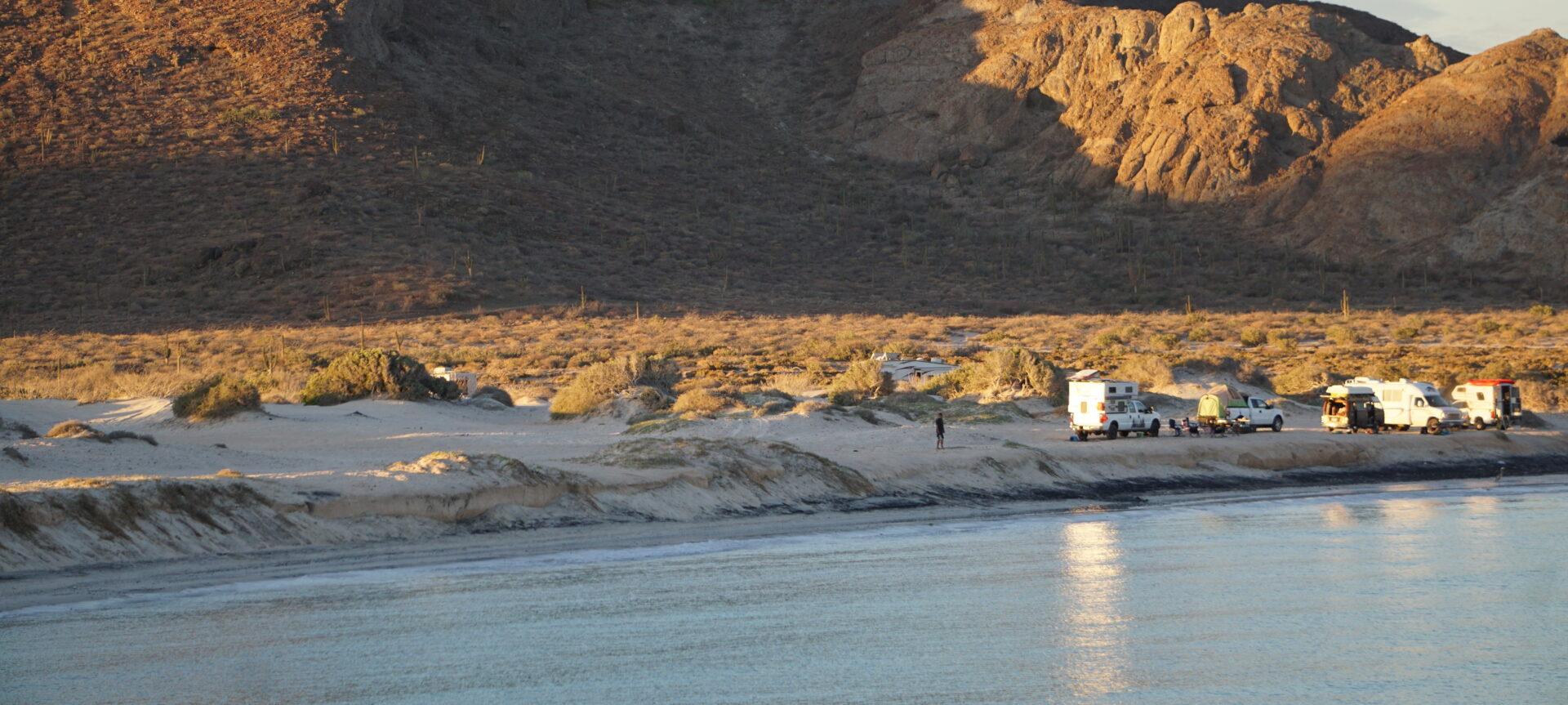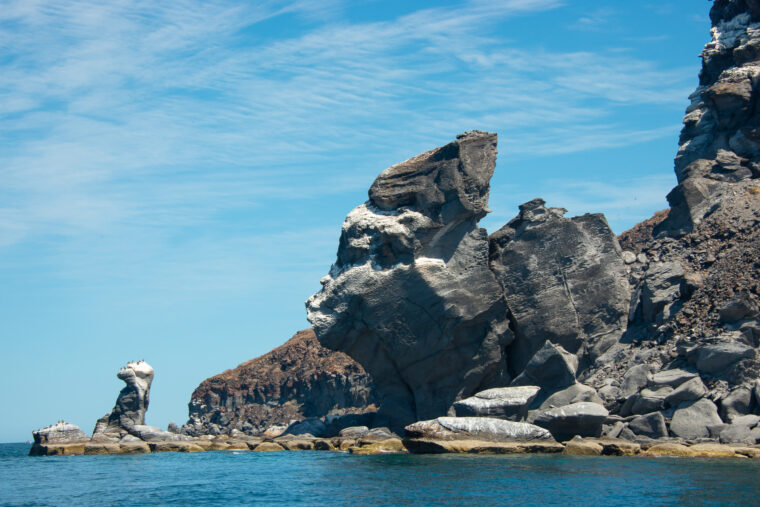For adventure seekers ready to roll down the windows and rock their rigs south of the border, Baja California is often the sights first set. Instagram photos promising free camping along desolate beaches leave many RVers dreaming of spending time in a beachside town among endless tacos and sunshine.
A Beginner’s Guide to Camping in the Baja Peninsula
Whether you’re just looking to get warm for the winter or thinking Baja might be a good place for an RV vacation, the peninsula makes for guaranteed adventure. Here are the towns and shorelines worth visiting along the way.
San Felipe
There are two ways to head into the heart of Baja, either from San Diego, California, and down along the Pacific Coast, or along the Gulf of California (formerly known as the Sea of Cortez), where your first beachside stop will be San Felipe. With its relatively sleepy oceanfront district full of locals selling their day’s catch out of coolers, and restaurants where instead of free chips and salsa they dole out heaping helpings of clams, this coastal village offers a vacation experience without an inflated price tag.
Beyond the oceanfront neighborhood, San Felipe is a bustling town with the last “big grocery store” you’ll find for hundreds of miles. La Palapa RV Camp features picturesque beachfront palapas (basically little shelters often equipped with a table and, in this case, RV hookups). With its central location, easily walkable from town, it’s the perfect place to adjust to RVing in another country.
South of San Felipe, Puertocitos offers a similar experience, plus a hot spring where the water’s temperature changes from frigid to scalding as it mixes with varying degrees of the sea during low and high tides.
Rancho Grande
This beachfront Rancho Grande campground offers palapas, some in further states of decay than others. The small village nearby features a restaurant with prices so reasonable that you’ll wonder why you even purchased groceries to cook in your rig.
The longevity of your stay will mostly depend on your level of comfort with what you’ve brought with you. Showers are nowhere to be found, and your personal needs otherwise will be at the mercy of not-oft cleaned outhouses, some tipped over, while a gas station back on the highway serves as your primary source of goods outside of the restaurant in town.
Bahía de los Ángeles
Farther south along Mexican Federal Highway 1 is Bahía de los Ángeles, which affords picturesque oceanfront living for less than $10 USD per night.
The road to Campo Archelon is best suited for vans and truck campers. While basic amenities like bathrooms are available, cell service (and internet access) is unlikely.
Guerrero Negro
After the endless stretch of MX-1 that serves as a gas desert and leaves more than a few travelers who didn’t fill up stranded, the relatively small town of Guerrero Negro seems like a metropolis.
The sheer number of mechanics alone shows how valued a destination these streets are to the greater area, and its main corridor is filled with restaurants, tallers (or workshops) of all professions, and places to replenish your water stores. Cell phone service fills the spaces between brightly painted homes and stores.
While camping is available in town at a restaurant’s parking lot, stock up for a few days worth of beach camping and head to Laguna Ojo de Liebre—a national preserve where a one-time admission price allows you to camp for as long as your supplies can support you.
Gray whales come here to raise their babies in the calm, safe waters of the bay. You can hire a tour guide to help you spot them. There’s a small museum and restaurant on-site as well, though it’s not within walking distance from the camping area.
Desierto de Vizcaíno
A small peninsula reaches westward into the Pacific Ocean from Guerrero Negro, where dirt roads and fishing poles are likely to see more desert pronghorns than cars going by.
Campo Sirena is a few square yards of sand and a small shack, but it’s yet another perfect place to relax and enjoy Baja. While the view of the beach is immediately blocked by some homes, a short walk allows you to see the horseback vaqueros riding their four-legged friends down the beach.
The town doesn’t offer much in the way of groceries or other services, and cell phone service is just enough to drive you crazy waiting for a Google search to load.
Leaving the Vizcaíno desert, Campo Rene feels like a cross between the resort from Dirty Dancing and a Mexican summer camp. Osprey and pelicans careen through the spaces between where the clearest sky meets the riparian wetlands, while dolphins jump out of the water to break their shadows. A restaurant with a large porch or a short walk to the sea provides escape from what is otherwise a small parking space for your campsite.
San Ignacio
The highlight of the next village along your way is a small square, lined with thrift stores and convenience stores, all bowing to a large church at the end of the park. Something closer to forest camping can be found along the palm tree-lined river that flows through town, particularly at Campo Los Petates, where waterfowl and Europeans setting up tents after a long day on motorcycles will be your neighbors.
If you’ve begun to fall more in love with the curious commonality that is camping in restaurant parking lots while traveling through Baja, the amusingly named Rice & Beans RV Park will leave you laughing at its concept of an “RV park,” but if you don’t mind yet another parking space with a restaurant—and in this case, a swimming pool—attached, you’ll be happy here.
Mulege
Mulege feels more like visiting someone’s hometown than a vacation destination, yet it has more places to camp than many other areas of Baja. It’s often thought of as the gateway to the scenic Bahía Concepción.
Luckily, the town can fill days, if not weeks, worth of exploring. It offers more traditional RV camping at Huerta Don Chano RV Park, or find yourself a spot in the grass and pick your own oranges at Hacienda de la Habana—there are even supplies to squeeze your own juice. You’ll likely have the place to yourself in the winter, but come summer its pool serves as a major hotspot for locals looking to cool off.
Bahía Concepción
Just as you’ve no doubt come in search of pristine beach camping in Baja California, so have other travelers. Somehow, it seems, they all end up at this bay within a bay on the Gulf of California.
Bahía Concepción offers ample free and cheap camping, as well as gorgeous landscapes. It’s close to Mulege, where travelers can easily stock up on supplies. Thanks to the tourist boom, there are plenty of places to drink, ice cream trucks, and more.
Find a palapa to hang your hammock at Playa El Burro, where you can sip margaritas at the adjacent bar by night and rent snorkeling and kayaking gear by day, or pull up a parking brake somewhere a bit less conspicuous, such as La Perla.
Puerto San Carlos
Crossing Baja from the Gulf of California to the Pacific Ocean, Villas Mar y Arena is a small resort with a restaurant that attracts locals and visitors alike. High and low tides are dramatic here, as is the sunset. San Carlos itself has plenty to refill your coffers or try a different restaurant than the one offered at Mar y Arena.
As for camping, you can purchase electricity for a small additional fee, but you’ll just be running an extension cord to a standard outlet on the patio. Your camping spot is typically just large enough for you to pull in and out of, but there’s no shortage of seating at the restaurant or beachfront.
Loreto
As you travel back to the gulf side of Baja and south, you’ll hit the largest city so far, Loreto. It’s a common stop for travelers, and Riviera del Mar RV Park rarely sees an empty night. Positioned in a part of town that allows for easy walking to many of the city’s attractions, you’ll find trinket shops and even the region’s former capitol buildings.
While much of Loreto is still very much a traditional Mexican town, the beachfront area is more of a built-up resort town. It’s a convenient place to get laundry done, fill up on water, and stock up the pantry for more reclusive locations once you leave town.
For those with four-wheel drive, a proper vehicle, and a daring spirit, there’s a twisting dirt road through the desert that transforms into a steep and rocky route down to the beachside village of Agua Verde.
El Conejo
El Conejo is a popular spot where surfers can be found catching waves, waiting to catch waves, and sitting on the beach.
There are three parts to this beachy camp. In the northern section, most of the campsites are located within tall coastal foliage. The hot spot for surfing lies in the middle, and you’ll find most surfers camping there. A third, more southerly area is significantly more remote and free.
La Paz
The Malecon, the area along the water in the center of La Paz, provides a range of dining experiences—from taco dives to upscale Mexican restaurants to tourist traps to an Applebees, plus a boardwalk that separates it from the water. This will be the first town where you’ll find chain stores like Walmart and McDonald’s. You can also catch the ferry here, headed to the mainland, should your desires lead you farther south.
A Christian summer camp, Campestre Maranatha, allows RVers similar amenities within driving distance to town. It features nice bathrooms, laundry, and a swimming pool, and loud late-night gatherings aren’t appreciated here.
North of town, beyond where one might grab the ferry, Cafe on the Beach provides a mini-resort experience where camping in the parking lot is permitted, while Playa Tecolote does so on a larger scale and with endless free camping.
Todos Santos
Todos Santos is famous for its abundance of art shops, many of which are filled with work from transplant artists. For a traveler having spent enough time in Baja to make it this far by vehicle, you’ll notice that it’s particularly more populated with American and Canadian vacationers, and the prices have been adjusted accordingly. You’ll find restaurants, cafes, and bars that cater to tourists.
While there is camping in Todos Santos proper, the free camping north of town at La Pastura tends to attract the most travelers.
Los Cabos
Cabo San Lucas is everything you might expect from a Mexican beach destination. A thriving town honking with traffic and every amenity you can imagine, including an upscale marina area, complete with a microbrewery and shopping mall, and endless stretches of packed beaches. The other Cabo, San José del Cabo, is a more typical city with a historic area worth visiting as well. You’ll find resorts dotting the beach along the well-maintained road between the two areas.
Los Cabos is also home to a small camping area. Cabo Surf Safari provides electricity and a bathroom with a shower. The owner’s home serves as a hostel, and the driveway is a campground for one or two small vehicles like a van, truck camper, or small Class C. There’s plenty to do within walking distance, and cabs are easy to find.
Los Barriles
Rounding the tip of the peninsula brings you to Los Barriles, an area that’s become popular with tourists. It features a traditional RV park with amenities as well as free camping.
Los Barriles Beach is an easy walk through the sand to oceanside restaurants and the small town itself, where no shortage of souvenir shops and taco stands await.
Martin Verdugo’s Beach Resort is a more typical RV park, still oceanfront (though not the sites), with a nice pool to boot, while Playa Norte RV Park is more laid back.
Whether you’ve come to avoid the cold of the north or to experience the joys of another culture in your RV, Baja is the perfect place to slow down and smell the ocean for a while.





























